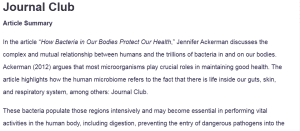Journal Club
Article Summary
In the article “How Bacteria in Our Bodies Protect Our Health,” Jennifer Ackerman discusses the complex and mutual relationship between humans and the trillions of bacteria in and on our bodies. Ackerman (2012) argues that most microorganisms play crucial roles in maintaining good health. The article highlights how the human microbiome refers to the fact that there is life inside our guts, skin, and respiratory system, among others: Journal Club.
These bacteria populate those regions intensively and may become essential in performing vital activities in the human body, including digestion, preventing the entry of dangerous pathogens into the body, and boosting the immune response (Ackerman, 2012). The author adds that scientists used research to understand how the balance of the microbiome is paramount for good health, and disturbances in this balance can lead to allergies and autoimmune diseases, as well as obesity and diabetes. This new understanding emphasizes the need to care for our microbiome for overall well-being.
One of the central themes of the article is that bacteria protect the body. The article discusses how bacteria, for instance, in the gut, help digest food and synthesize vital nutrients such as some vitamins and short-chain fatty acids. They are also crucial in training the immune system by teaching it to differentiate what is harmful and what is not. Ackerman (2012) also argues that beneficial bacteria can block harmful pathogens from colonizing our bodies through competitive exclusion, whereby good bacteria take up the space and compete for resources, “crowding out” pathogenic organisms.
For example, the skin, mouth, and respiratory tract all contain bacteria that form protective barriers against invading pathogens. Ackerman (2012) asserts that these microbiomes enable bacteria to interact with our cells and with each other, strengthening their protective functions and highlighting the critical role bacteria play in improving health and preventing disease. The article also discusses the possible harm caused by the overuse of antibiotics, poor diet, and a lack of interaction with environmental microbes in modern life. Microbiome asymmetry brought on by excessive antibiotic usage may be linked to a number of health issues.
For instance, while antibiotics might be quite efficient in clearing the body of hazardous bacteria, they can also damage beneficial microbes because some bad bacteria take their place. In addition, a diet lacking fiber and rich in industrially prepared foods may lower gut bacterial diversity, making it impossible for the human body to successfully defend against disease. Ackerman (2012) also argues that the restoration of balance in the microbiome through changes in diet, probiotics, and even fecal transplantation has been promising in alleviating some health conditions. These further point out the importance of a holistic approach to health, focusing not only on treatment but also on nurturing the diverse microbial ecosystems that underpin our well-being.
Connection Points
The article is connected to the class discussions regarding the various roles of microbes in human health. For instance, it connects to discussions regarding the balance between ‘good’ and ‘bad’ bacteria. The idea of the microbiome as a sort of ‘protective ecosystem’ inside the body resonates with the notion that microorganisms are not just pathogens but are necessary for homeostasis.
Another connection to the content of our course is in the discussion of antibiotic use and the consequences on microbial communities. This connects with the study of resistance and understanding how antibiotics affect pathogenic and non-pathogenic bacteria. For instance, Ackerman (2012) illustrates some of the broader implications of anti-microbial treatments on human health.
References
Ackerman, J. (2012, June 1). How bacteria in our bodies protect our health. Scientific American. https://www.scientificamerican.com/article/ultimate-social-network-bacteria-protects-health/
ORDER A PLAGIARISM-FREE PAPER HERE
We’ll write everything from scratch
Question
During the semester, we will discuss current research topics. You will be required to read and summarize an assigned research article. You will need to provide 2 “connection points” (how this article relates/connects to the material we are covering in class) at the end of your written summary.
Summaries have scheduled due dates in Packback and will be due within those timeframes. These assignments cannot be made up if you miss the due date.
Packback Deep Dives will be used to assess independent research skills and improve academic communication through long-form writing assignments such as essays, papers, and case studies. While completing the summative writing prompts (Journal club assignments) on Deep Dives, you will interact with a Research Assistant that will help you gather your notes and cite your sources, and Digital Writing Assistant for in-the-moment feedback and guidance on your writing.

Journal Club
Here are some guidelines to follow when writing your Journal Club summary
- 3 to 4-paragraph format
- Length: 300 – 1000 words
- Genus and species names of bacteria must be italicized (ex: Staphylococcus aureus). **Notice the genus is capitalized, but the species name is not
- You can submit the paper through PackBack
- All Journal Club assignments will be evaluated for plagiarism. If you are plagiarizing, I WILL find out.
- Citations need to be in APA format (you should cite the article we are discussing). If you choose to do independent research, make sure you cite it. All outside sources need to be primary or secondary sources.
- Primary sources are published, peer-reviewed research.
- An example of a secondary source would be a published, peer-reviewed review article (the researcher summarizes other published data and primary sources).
Client’s Note:
- Assigned research article:

